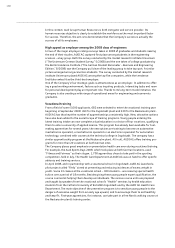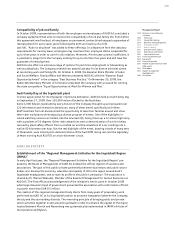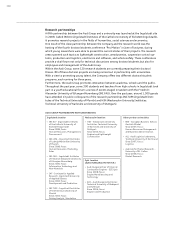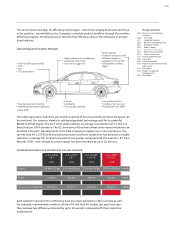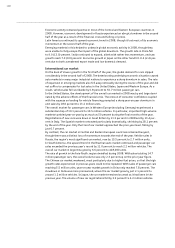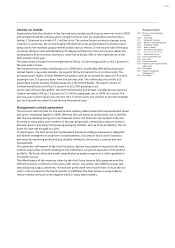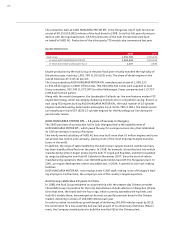Audi 2008 Annual Report Download - page 163
Download and view the complete annual report
Please find page 163 of the 2008 Audi annual report below. You can navigate through the pages in the report by either clicking on the pages listed below, or by using the keyword search tool below to find specific information within the annual report.
144
Today, all prototypes undergo more than 1,000 hours of testing in the wind tunnel. Since a
vehicle’s underbody contributes to as much as 40 percent of the total drag, an aerodynamic
underbody – a system of aerodynamically effective underbody components – was designed. This
is now used in all current Audi models, thereby reducing fuel consumption. The new Audi Q5’s
low drag coefficient of 0.33 is the latest example of just how valuable this important work is.
TDI and TFSI technology – powerful and economical
About 50 percent of the fuel’s energy is lost in a vehicle’s internal combustion engine. Develop-
ing powerful but economical engines is therefore one of the most obvious ways to enhance fuel
efficiency and reduce emissions.
In 1989, the Audi Group’s engineers made ground-breaking progress in this field. For the very
first time, diesel direct injection featuring fully electronic control was combined with turbo-
charging in a production model – a move that paved the way for today’s ultra-efficient diesel
engines. The effectiveness of modern TDI technology was showcased to stunning effect in 2006
when the Audi R10 TDI became the first diesel racing car in the world to win the 24 Hours of
Le Mans – and then repeated this feat in 2007 and 2008.
TDI clean diesel technology, which involves injecting an aqueous ammonia solution into the
exhaust system, will go into production in 2009. Since this technology almost completely elimi-
nates nitrogen oxides, the engine already meets limit values of both the Euro 6 standard, which
doesn’t come into effect until 2014, and the Californian ULEV II BIN 5 emission standard, cur-
rently the world’s toughest.
The advent of evolutionary FSI technology in 2002 represented a major landmark in gasoline
engine technology. In combination with turbocharging (TFSI) and controlled valve lift (Audi
valvelift system) – two technologies that increase torque and output, and enhance fuel effi-
ciency – today’s modern gasoline engines have become synonymous with superlative pulling
power and maximum efficiency.
Audi Space Frame (ASF) – safe and light
A prerequisite for a vehicle using fuel efficiently is reduced weight.
In 1994, the advent of the Audi Space Frame (ASF) revolutionized lightweight automotive con-
struction. Thanks to the high-strength, all-aluminum body, it has a significant weight advantage
over conventional steel bodies and therefore a built-in advantage when it comes to enhancing
fuel efficiency and reducing emissions. For instance, the weight difference for the Audi A8 luxury
sedan is in the order of 140 kilograms.
With the introduction of its sporty Audi TT in 2006, the Audi Group unveiled a further develop-
ment in its progressive aluminum technology. Using state-of-the-art manufacturing methods,
this vehicle body is a hybrid structure comprised of both steel and aluminum.
Audi S tronic – sporty and efficient
In order to more effectively exploit the fuel potential of its thrifty TDI and TFSI engines, the
Audi Group has also broken new ground in transmission technology. 2003 was the year that saw
the Audi S tronic dual-clutch transmission go into production. This enables gear changes to be
performed with virtually no detectable interruption to the power flow, and the low engine
speeds and shorter shifting times add up to exceptionally economical road performance. The
new seven-speed S tronic dual-clutch transmission has been on the market since 2008. With its
impressive efficiency and intelligent control function in automatic mode, it allies the accus-
tomed sportiness of an Audi with even greater economy.
Efficiency – the sum of all parts
Trendsetting innovations such as those described above have helped the Audi Group produce
impressively efficient vehicle concepts in the past. For example, the Company went into volume
production as early as 2001 with the Audi A2 1.2 TDI, a four-door, three-liter (referring to fuel
consumption per 100 kilometers) car.






